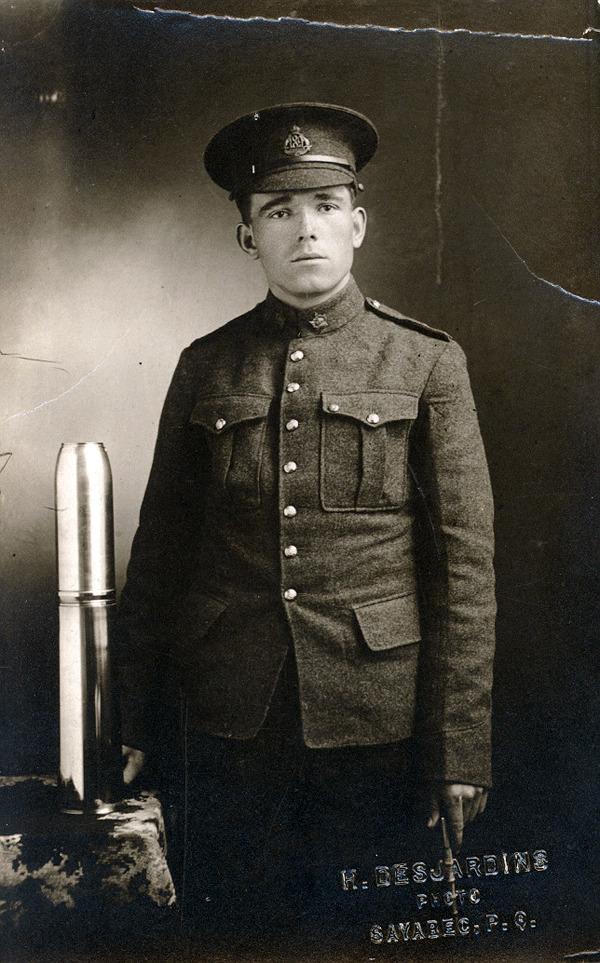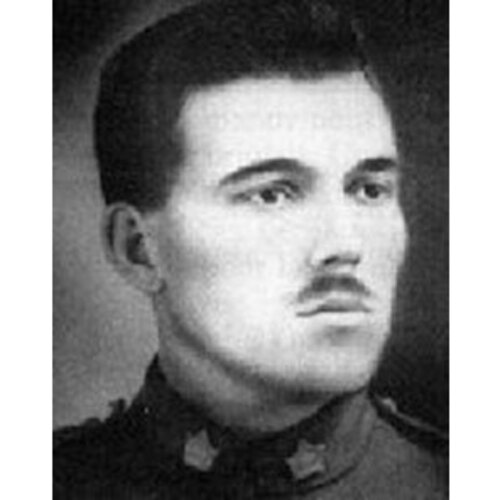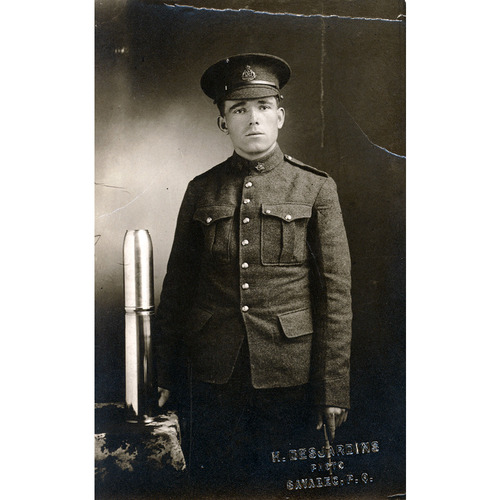
Source: Link
KAEBLE, JOSEPH, mechanic and soldier; b. 5 May 1892 in Saint-Moïse, Que., son of Joseph Kaeble, a farmer, and Marie Ducas; d. 9 June 1918 in Neuville-Vitasse, France.
The first Canadian ancestor of Joseph Kaeble’s family, Thodor Göbel, came from Mainz (Germany). Göbel is believed to have arrived in the province of Quebec in 1776 with the troops from the duchy of Brunswick, which were under the command of Friedrich Adolph von Riedesel.
Born in Saint-Moïse, east of Mont-Joli, Joseph Kaeble lived in the Gaspé until the age of 22. He had a brother, a sister, and a half-brother. His father died when he was still a child, and the family then settled in Sayabec, a village at the head of Lac Matapédia. There Kaeble attended the school run by the Frères de la Croix de Jésus, where he was remembered as a serious and energetic student. Later he worked as a mechanic at a local sawmill.
World War I completely changed Kaeble’s life. According to family tradition, he had developed an interest in military life even before the outbreak of hostilities. As a schoolboy, it was said, he liked to carve wooden soldiers and stage mock battles. Whatever one makes of these recollections, when in 1916 Lieutenant-Colonel Philippe-Auguste Piuze, a highly regarded businessman and militia officer in Fraserville (Rivière-du-Loup) and Saint-Germain-de-Rimouski (Rimouski), raised the 189th Infantry Battalion, Joseph Kaeble was among the many residents of the lower St Lawrence region and the Gaspé to sign up as volunteers.
Kaeble was one of about ten recruits who enlisted on 20 March 1916 in Sayabec. The initial organization and training of infantry units took place at Valcartier during the war; Kaeble spent six months there before leaving for England on 27 September. Events in Europe developed as he had hoped. The 22nd Infantry Battalion, the only French Canadian battalion to fight on the continent, had lost many men in the previous months, first at Saint-Eloi (Sint-Elooi) and Mount Sorrel in Belgium, and then at Courcelette and Regina Trench in France. So reinforcements were badly needed. Kaeble was immediately assigned to the 69th Infantry Battalion. That unit, which had been in England since April, was transferred on 13 November to the 22nd, then in the throes of reorganization at Bully-Grenay, a small community northwest of Lens, France.
Called to help defend a large sector between Arras and Lens, the 22nd spent the winter of 1916–17 in this region. In April Kaeble took part in the famous offensive against Vimy Ridge which resulted in a stunning victory for the Canadian Expeditionary Force on the 12th of that month. Even if Kaeble’s name, like those of thousands of fellow infantrymen, was not mentioned in dispatches and other documents of the sort, we know he was there and participated in the action. Some 12 days after this memorable victory, while the Canadian troops were still under enemy fire, he was wounded in the right shoulder and was transported back behind the lines. He stayed there 25 days, first at No.13 General Hospital and then at No.1 Convalescent Depot, both in Boulogne. Despite this set-back, Kaeble remained in good spirits. In a letter to his sister, he said he had only very good news, that he himself was doing well, that he was plumper than he had ever been, in short, that he was not too worried and that he sent his regards to his female friends. Judging from other letters, one of these young women, to whom he wrote regularly, was in all likelihood a special friend, possibly a fiancée.
Kaeble left Boulogne for the front on 25 May 1917. Back with his unit, he resumed his post as a machine-gunner, a job he said he really enjoyed. For the 22nd battalion, Vimy was followed by Hill 70 in August, Passchendaele (Passendale), Belgium, in October, and then the Neuville-Vitasse sector and Mercatel from the end of March 1918. Good news awaited Kaeble in the last sector. On 23 April he was made corporal, replacing a comrade who had been promoted. Tragic events, however, also lay ahead.
Kaeble had made a will before leaving Sayabec, standard procedure for soldiers upon enlistment. Did he really think, however, that he could die in combat? His extant letters express undeniable optimism, but also firm realism. Although he often wrote about his return home and the pleasure he would have in seeing his loved ones again, he did not exclude the possibility that one day he would be cut down by the enemy. “I pray to God every day that I may see you again,” reads a letter dated 29 Sept. 1917, “but that does not prevent me from doing my duty at the front. We must fear only the Good Lord. Here we fear nothing, except God.”
The events of 8 June 1918 showed that Kaeble indeed had no fear. That night, at 9:45, the enemy attempted a strong raid in the sector defended by the 22nd battalion. After an intense artillery bombardment, a three-pronged German attack was launched. At the post defended by Kaeble’s machine-gun section the resistance was truly heroic. “As soon as the barrage lifted from the front line,” according to official documents, “about fifty of the enemy advanced towards his post. By this time the whole of his section except one had become casualties. Corporal Kaeble jumped over the parapet, and, holding his Lewis gun at the hip, emptied one magazine after another into the advancing enemy, and, although wounded several times by fragments of shells and bombs, he continued to fire, and entirely blocked the enemy by his determined stand. Finally, firing all the time, he fell backwards into the trench[,] mortally wounded. While lying on his back in the trench he fired his last cartridges over the parapet at the retreating Germans, and before losing consciousness shouted to the wounded about him: ‘Keep it up boys, do not let them get through. We must stop them.’”
Transported to hospital, Corporal Joseph Kaeble died of his wounds the next night. He was buried in the local cemetery in Wantequin, some seven miles west of Arras. Decorated with the Military Medal, he also was awarded the Victoria Cross, the highest British distinction. He was the first French Canadian soldier to be given this honour. Streets, buildings, and even a mountain still bear his name and keep his memory alive.
ANQ-BSLGIM, CE1-25, 5 mai 1892. Arch. de la Régie du Royal 22e Régiment (Québec), Dossiers hist. du personnel, 7444 (Joseph Kaeble). NA, RG 150, Acc. 1992–93/166, box 4994. London Gazette, 16 Sept., 7 Oct. 1918. La Patrie, 10 juill. 1918. Le Progrès du Golfe (Rimouski, Qué.), 20 déc. 1918, 15 févr. 1935. L’Amicale du 22e Inc. (Québec), 1 (1947), no.9: 5; 2 (1948), no.6: 11; 7 (1953), no.5: 13; 8 (1954), no.10: 21; 10 (1956), no.3: 2; 13 (1959), no.3: 3; 18 (1964), no.11: 4. Centenaire: Joseph Kaeble, 1892; Sayabec, 1992 ([Sayabec, Qué., 1992]). Joseph Chaballe, Histoire du 22e bataillon canadien-français . . . (Montréal, 1952). La Citadelle (Québec), 10 (1974), no.4: 3. J.-P. Gagnon, Le 22e bataillon (canadien-français), 1914–1919; étude socio-militaire (Québec et Ottawa, 1986). Micheline [Kaeble] Hébert, Joseph Kaeble: croix Victoria ([Saint-Hubert, Qué.], 1992). Léopold Lamontagne, Les archives régimentaires des Fusiliers du Saint-Laurent (Rimouski, 1943), 149–52. G. C. Machum, Canada’s V.C.’s; the story of Canadians who have been awarded the Victoria Cross . . . (Toronto, 1956). Nicholson, CEF. Noms et lieux du Québec: dictionnaire illustré, sous la direction de la Commission de toponymie du Québec (Québec, 1994), 305. J. G. Scott, “Uncommon valour: Canadian winners of the Victoria Cross,” Then and Now (Ottawa), 4 (1994), no.4: 30–31. Valiant men: Canada’s Victoria Cross and George Cross winners, ed. John Swettenham (Toronto, 1973).
Cite This Article
Jacques Castonguay, “KAEBLE, JOSEPH,” in Dictionary of Canadian Biography, vol. 14, University of Toronto/Université Laval, 2003–, accessed January 5, 2025, https://www.biographi.ca/en/bio/kaeble_joseph_14E.html.
The citation above shows the format for footnotes and endnotes according to the Chicago manual of style (16th edition). Information to be used in other citation formats:
| Permalink: | https://www.biographi.ca/en/bio/kaeble_joseph_14E.html |
| Author of Article: | Jacques Castonguay |
| Title of Article: | KAEBLE, JOSEPH |
| Publication Name: | Dictionary of Canadian Biography, vol. 14 |
| Publisher: | University of Toronto/Université Laval |
| Year of publication: | 1998 |
| Year of revision: | 1998 |
| Access Date: | January 5, 2025 |




